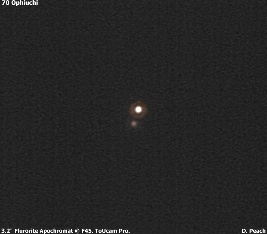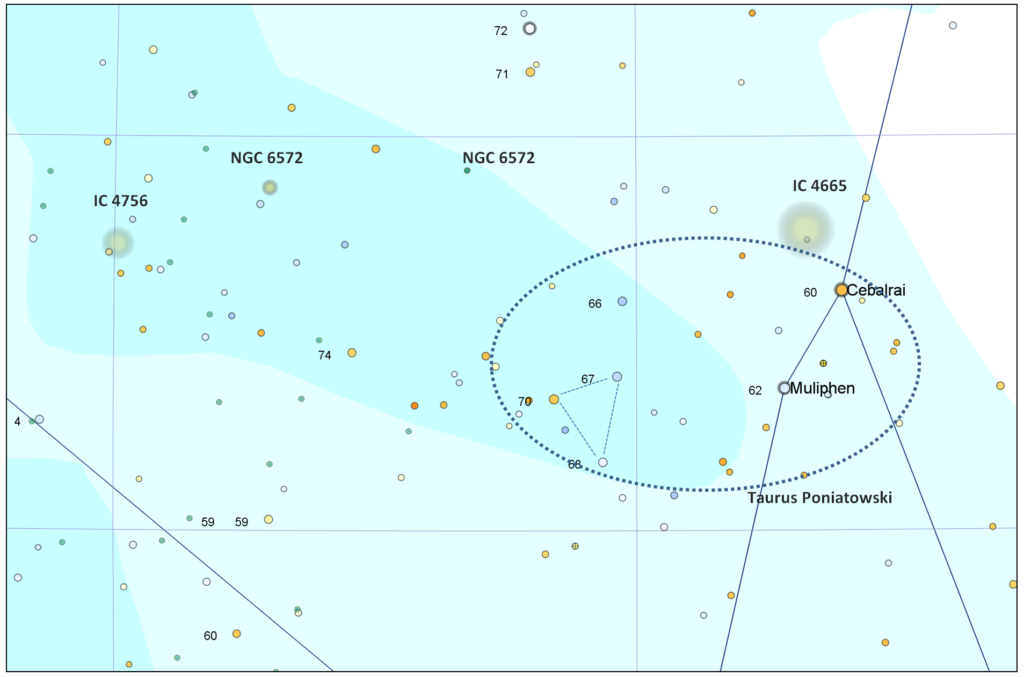
When it comes to observing the stars and other sights beyond our solar system, there’s always something new to see. But once you see it, chances are it’s not going to chance much in the coming years. That’s because things move slowly in the cosmos, at least compared to a human lifetime.
There are, however, a few exceptions. One of the most important for astronomers is the nearby binary star called 70 Ophiuchi, a little gem in the asterism known as Taurus Poniatowski in the constellation Ophiuchus. It’s a beautiful star for casual stargazers armed with a small telescope. Serious stargazers can watch over the course of a year or two to detect the motion of the two components as they slowly revolve around each other during their 88-year period. It’s one of the few double stars that make a complete revolution within the course of a human lifetime.
At a distance of just 16 light years, 70 Oph is a relatively nearby star. Both components are small orange main sequence stars, each with a mass of about 90% that of our Sun. One shines about half as brightly as the Sun, while the other is just 1/7 as bright.
70 Oph was first cataloged by William Herschel in the late 18th century. An astute observer, Herschel noted the apparent motion of the two stars around each other, and subsequent studies showed the stars follow a motion predicted by Newton’s Law of Gravitation, a law discovered by examining the motion of the planets in our solar system. The measurements of 70 Oph helped astronomers show the same physical principles apply not just to our solar system, but to the galaxy as a whole.
Also, by carefully mapping out the motion of the components of 70 Oph, astronomers used Newton’s principles to calculate the mass of the stars. This was a first step towards a deeper understanding of what makes stars tick.

From our vantage point, the two components of 70 Oph have an apparent magnitude 4.2 and 5.9, so the pair is visible to the unaided eye as a single point of light. In this second decade of the 21st century, the pair is separated by about 5″, which means you can resolve them in nearly any telescope using a magnification of 75x to 100x or so. The brighter star has a yellow-gold color while the fainter looks orange-red. Some observers report a tinge of violet in the fainter star.
(Pro tip: to improve your visual perception of color when observing stars, move your telescope out of focus just a touch to expand the size of the image of the star on the back of your retina. Yes, this really works).
The average distance between the two components of 70 Oph is about the same as the distance between the Sun and Uranus. The stars made their most recent closest approach in 1989. Since then, their separation has quickly increased from a tight 1.7″ to a more spacious 5″. In many studies, astronomers suggested the indirect detection of planets around one of the components of 70 Oph. But so far, these detections remain unconfirmed.

70 Ophiuchi lies at the tip of the horns of the little asterism known as Taurus Poniatowski in the constellation Ophiuchus. The area is a rich trove of fascinating objects for observers armed with a small telescope. If you’re hankering for a more serious tour of the area, this previous article will set you up for a night of good stargazing.
Share This: